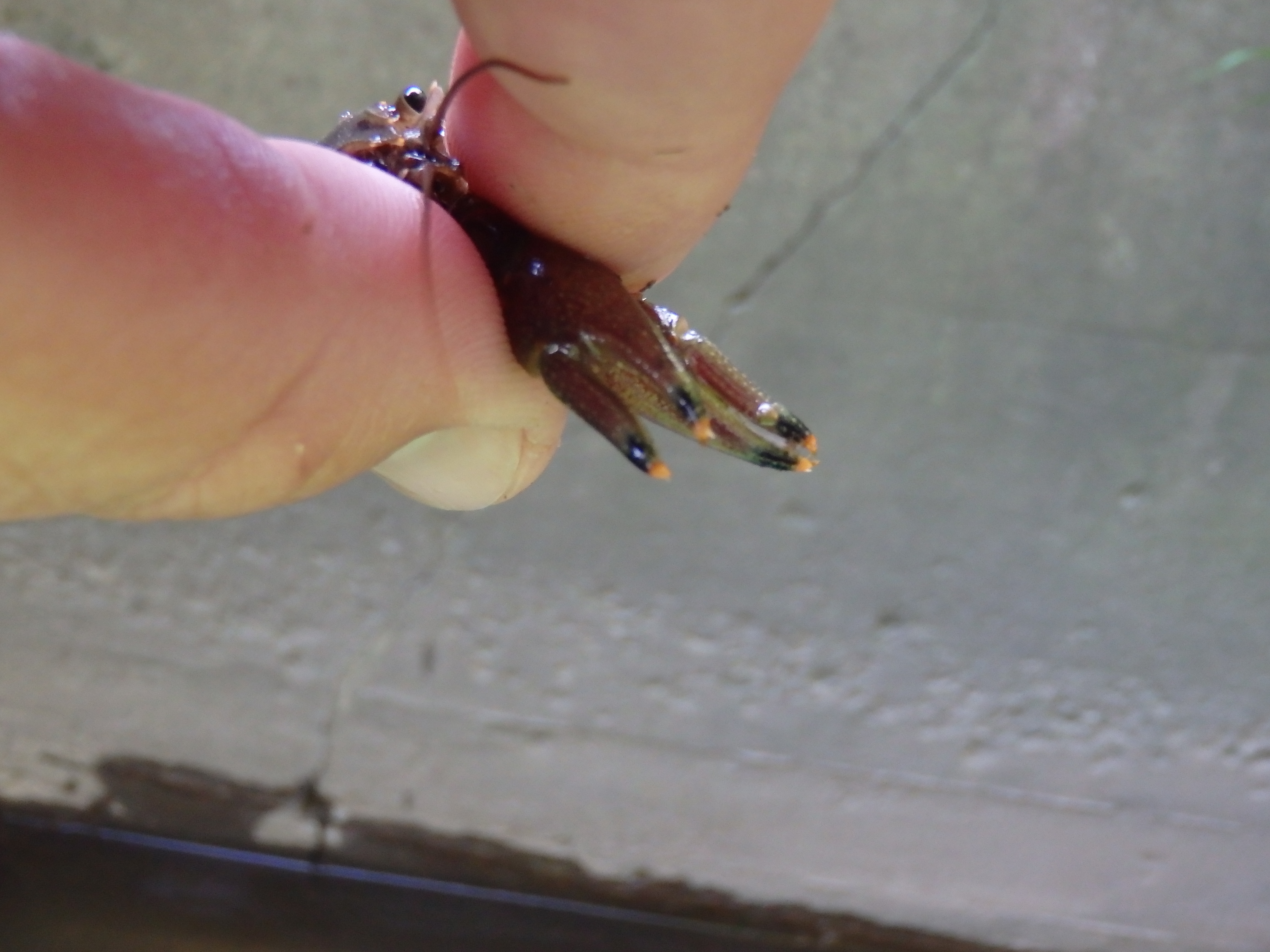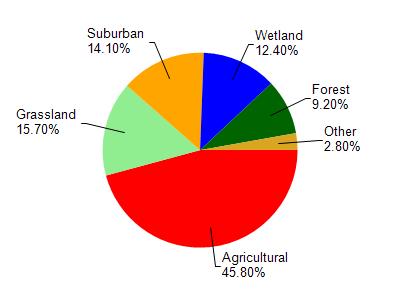
5.79 Miles
0 - 5.79
Cool-Cold Headwater, Cool-Warm Headwater
2024
Good
Brown
No
No
No
Fish and Aquatic Life
Overview
Beaver Dam Creek is a small, shallow stream originating Southwest High School and meanders its way north 4 miles to eventually drain into the Duck Creek near Velp Avenue. The stream is very flashy and carries a considerable sediment load. Substrate is made up of gravel, cobble and some soft sediments. The stream has a "fair" habitat rating below Memorial Drive. Macroinvertebrates collected there in October 1994 rated water quality as "poor", in April 1995 water quality was rated as "fairly poor".
Oxygen levels recorded in August and September 1995 never fell below 6 mg/l. This stream has a history of fish kills occurring every 2-3 years since the 1970's. they have been caused by ammonia spills, discharges of blood (very high BOD) from a rendering plant and other, mostly industrial practices. Fish kills are not normally severe in Beaver Dam Creek because there are not many resident fish present and most of the fish that are there can migrate downstream to Duck Creek and Green Bay. No fish surveys were conducted during the priority watershed appraisal monitoring, though it is presumed that any fish species living in Duck Creek can travel up Beaver Dam Creek (Johnson 1996).
Date 1999
Author Cheryl Bougie
Condition
Wisconsin has over 84,000 miles of streams, 15,000 lakes and milllions of acres of wetlands. Assessing the condition of this vast amount of water is challenging. The state's water monitoring program uses a media-based, cross-program approach to analyze water condition. An updated monitoring strategy (2015-2020) is now available. Compliance with Clean Water Act fishable, swimmable standards are located in the Executive Summary of Water Condition in 2018. See also the 'monitoring and projects' tab.
Reports
Management Goals
Wisconsin's Water Quality Standards provide qualitative and quantitative goals for waters that are protective of Fishable, Swimmable conditions [Learn more]. Waters that do not meet water quality standards are considered impaired and restoration actions are planned and carried out until the water is once again fishable and swimmable
Management goals can include creation or implementation of a Total Maximum Daily Load analysis, a Nine Key Element Plan, or other restoration work, education and outreach and more. If specific recommendations exist for this water, they will be displayed below online.
Monitoring
Monitoring the condition of a river, stream, or lake includes gathering physical, chemical, biological, and habitat data. Comprehensive studies often gather all these parameters in great detail, while lighter assessment events will involve sampling physical, chemical and biological data such as macroinvertebrates. Aquatic macroinvertebrates and fish communities integrate watershed or catchment condition, providing great insight into overall ecosystem health. Chemical and habitat parameters tell researchers more about human induced problems including contaminated runoff, point source dischargers, or habitat issues that foster or limit the potential of aquatic communities to thrive in a given area. Wisconsin's Water Monitoring Strategy was recenty updated.
Grants and Management Projects
Monitoring Projects
| WBIC | Official Waterbody Name | Station ID | Station Name | Earliest Fieldwork Date | Latest Fieldwork Date | View Station | View Data |
|---|
| 410100 | Beaver Dam Creek | 053230 | Beaver Dam Creek - Taylor St 85 Ft Up | 8/19/1976 | 7/30/1979 | Map | Data |
| 410100 | Beaver Dam Creek | 10059792 | Duck Creek from Park to Riverside Launch | | | Map | Data |
| 410100 | Beaver Dam Creek | 10048171 | Beaver Dam Creek 10m US confluence of Sanimax Discharge Channel | 2/28/2017 | 2/28/2017 | Map | Data |
| 410100 | Beaver Dam Creek | 10007662 | Bever Dam Creek at Velp Ave | | | Map | Data |
| 410100 | Beaver Dam Creek | 053558 | Beaver Dam Creek - Memorial Drive | 1/12/1994 | 9/30/2024 | Map | Data |
| 410100 | Beaver Dam Creek | 10033957 | Beaver Dam Creek- US S Taylor St | 7/18/2011 | 1/1/2015 | Map | Data |
| 410100 | Beaver Dam Creek | 10007661 | Beaver Dam Creek at Lone Grove Ave | | | Map | Data |
| 410100 | Beaver Dam Creek | 10007663 | Beaver Dam Creek at Vincent Rd | 7/20/2015 | 8/17/2019 | Map | Data |
| 410100 | Beaver Dam Creek | 10034514 | Beaver Dam Creek-West of Memorial Dr. | 6/9/2011 | 10/7/2015 | Map | Data |
| 409700 | Duck Creek | 10059792 | Duck Creek from Park to Riverside Launch | | | Map | Data |
|

Watershed Characteristics
Beaver Dam Creek is located in the Duck Creek watershed which is 151.61 mi². Land use in the watershed is primarily agricultural (45.80%), grassland (15.70%) and a mix of suburban (14.10%) and other uses (24.40%). This watershed has 302.11 stream miles, 2,064.01 lake acres and 8,189.35 wetland acres.
Nonpoint Source Characteristics
This watershed is ranked High for runoff impacts on streams, Not Available for runoff impacts on lakes and High for runoff impacts on groundwater and therefore has an overall rank of High. This value can be used in ranking the watershed or individual waterbodies for grant funding under state and county programs.However, all waters are affected by diffuse pollutant sources regardless of initial water quality. Applications for specific runoff projects under state or county grant programs may be pursued. For more information, go to surface water program grants.
Beaver Dam Creek is considered a Cool-Cold Headwater, Cool-Warm Headwater under the state's Natural Community Determinations.
Natural communities (stream and lake natural communities) represent model results and DNR staff valiation processes that confirm or update predicted conditions based on flow and temperature modeling from historic and current landscape features and related variables. Predicated flow and temperatures for waters are associated predicated fish assemblages (communities). Biologists evaluate the model results against current survey data to determine if the modeled results are corect and whether biological indicators show water quaity degradation. This analysis is a core component of the state's resource management framework. Wisconsin's Riverine Natural Communities.
Cool (Warm-Transition) Headwaters are small, sometimes intermittent streams with cool to warm summer temperatures. Coldwater fishes are uncommon to absent, transitional fishes are abundant to common, and warm water fishes are common to uncommon. Headwater species are abundant to common, mainstem species are common to absent, and river species are absent.
Cool (Cold-Transition) Headwaters are small, usually perennial streams with cold to cool summer temperatures. Coldwater fishes are common to uncommon (<10 per 100 m), transitional fishes are abundant to common, and warm water fishes are uncommon to absent. Headwater species are abundant to common, mainstem species are common to absent, and river species are absent.